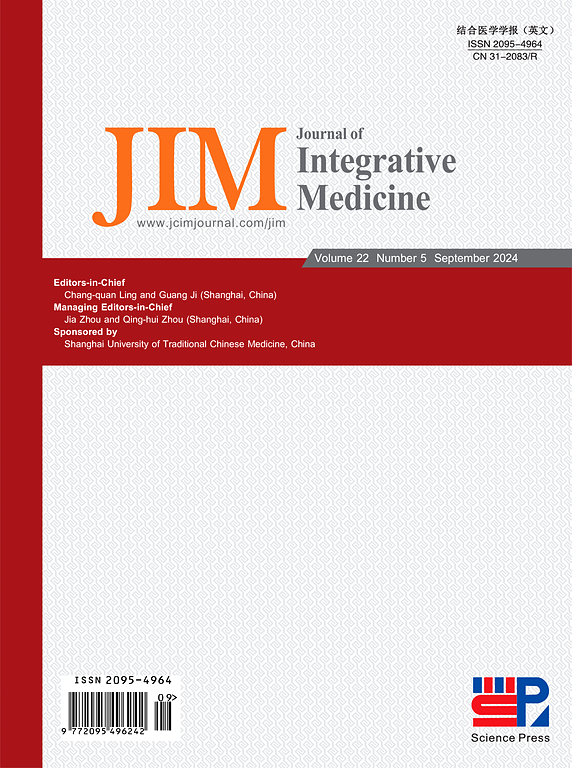Ginsenoside Rg1 promotes non-rapid eye movement sleep via inhibition of orexin neurons of the lateral hypothalamus and corticotropin-releasing hormone neurons of the paraventricular hypothalamic nucleus
IF 4
2区 医学
Q1 INTEGRATIVE & COMPLEMENTARY MEDICINE
引用次数: 0
Abstract
Objective
This study investigates the sleep-modulating effects of ginsenoside Rg1 (Rg1, C42H72O14), a key bioactive component of ginseng, and elucidates its underlying mechanisms.
Methods
C57BL/6J mice were intraperitoneally administered doses of Rg1 ranging from 12.5 to 100 mg/kg. Sleep parameters were assessed to determine the average duration of each sleep stage by monitoring the electrical activity of the brain and muscles. Further, orexin neurons in the lateral hypothalamus (LH) and corticotropin-releasing hormone (CRH) neurons in the paraventricular hypothalamic nucleus (PVH) were ablated using viral vector surgery and electrode embedding. The excitability of LHorexin and PVHCRH neurons was evaluated through the measurement of cellular Finkel-Biskis-Jinkins murine osteosarcoma viral oncogene homolog (c-Fos) expression.
Results
Rg1 (12.5–100 mg/kg) augmented the duration of non-rapid eye movement (NREM) sleep phases, while reducing the duration of wakefulness, in a dose dependent manner. The reduced latency from wakefulness to NREM sleep indicates an accelerated sleep initiation time. We found that these sleep-promoting effects were weakened in the LHorexin and PVHCRH neuron ablation groups, and disappeared in the orexin and CRH double-ablation group. Decreased c-Fos protein expression in the LH and PVH confirmed that Rg1 promoted NREM sleep by inhibiting orexin and CRH neurons.
Conclusion
Rg1 increases the duration of NREM sleep, underscoring the essential roles of LHorexin and PVHCRH neurons in facilitating the sleep-promoting effects of Rg1.
Please cite this article as: Wang YY, Wu Y, Yu KW, Xie HY, Gui Y, Chen CR, Wang NH. Ginsenoside Rg1 promotes non-rapid eye movement sleep via inhibition of orexin neurons of the lateral hypothalamus and corticotropin-releasing hormone neurons of the paraventricular hypothalamic nucleus. J Integr Med. 2024; 22(6): 721–730.
人参皂苷Rg1通过抑制下丘脑外侧的奥曲肽神经元和下丘脑室旁核的促肾上腺皮质激素释放激素神经元,促进非快速眼动睡眠。
研究目的本研究探讨了人参皂苷 Rg1(Rg1,C42H72O14)(人参的一种主要生物活性成分)的睡眠调节作用,并阐明了其潜在机制:方法:给 C57BL/6J 小鼠腹腔注射 12.5 至 100 mg/kg 剂量的 Rg1。通过监测大脑和肌肉的电活动,评估睡眠参数以确定每个睡眠阶段的平均持续时间。此外,还使用病毒载体手术和电极嵌入法消融了下丘脑外侧(LH)的奥曲肽神经元和下丘脑室旁核(PVH)的促肾上腺皮质激素释放激素(CRH)神经元。通过测量细胞Finkel-Biskis-Jinkins小鼠骨肉瘤病毒癌基因同源物(c-Fos)的表达,评估了LHorexin和PVHCRH神经元的兴奋性:结果:Rg1(12.5-100 毫克/千克)以剂量依赖的方式延长了非快速眼动(NREM)睡眠阶段的持续时间,同时缩短了觉醒的持续时间。从觉醒到非快速眼动睡眠的潜伏期缩短表明睡眠启动时间加快。我们发现,这些促进睡眠的作用在 LHorexin 和 PVHCR 神经元消融组中减弱,而在 orexin 和 CRH 双消融组中消失。LH和PVH中c-Fos蛋白表达的减少证实了Rg1通过抑制orexin和CRH神经元来促进NREM睡眠:结论:Rg1能延长NREM睡眠时间,强调了LHorexin和PVHCRH神经元在促进Rg1的睡眠效应中的重要作用。本文引用如前Wang YY, Wu Y, Yu KW, Xie HY, Gui Y, Chen CR, Wang NH.人参皂苷Rg1通过抑制下丘脑外侧的奥曲肽神经元和下丘脑室旁核的促肾上腺皮质激素释放激素神经元促进非快速眼动睡眠。J Integr Med . 2024; Epub ahead of print.
本文章由计算机程序翻译,如有差异,请以英文原文为准。
求助全文
约1分钟内获得全文
求助全文
来源期刊

Journal of Integrative Medicine-Jim
Medicine-Complementary and Alternative Medicine
CiteScore
9.20
自引率
4.20%
发文量
3319
期刊介绍:
The predecessor of JIM is the Journal of Chinese Integrative Medicine (Zhong Xi Yi Jie He Xue Bao). With this new, English-language publication, we are committed to make JIM an international platform for publishing high-quality papers on complementary and alternative medicine (CAM) and an open forum in which the different professions and international scholarly communities can exchange views, share research and their clinical experience, discuss CAM education, and confer about issues and problems in our various disciplines and in CAM as a whole in order to promote integrative medicine.
JIM is indexed/abstracted in: MEDLINE/PubMed, ScienceDirect, Emerging Sources Citation Index (ESCI), Scopus, Embase, Chemical Abstracts (CA), CAB Abstracts, EBSCO, WPRIM, JST China, Chinese Science Citation Database (CSCD), and China National Knowledge Infrastructure (CNKI).
JIM Editorial Office uses ThomsonReuters ScholarOne Manuscripts as submitting and review system (submission link: http://mc03.manuscriptcentral.com/jcim-en).
JIM is published bimonthly. Manuscripts submitted to JIM should be written in English. Article types include but are not limited to randomized controlled and pragmatic trials, translational and patient-centered effectiveness outcome studies, case series and reports, clinical trial protocols, preclinical and basic science studies, systematic reviews and meta-analyses, papers on methodology and CAM history or education, conference proceedings, editorials, commentaries, short communications, book reviews, and letters to the editor.
Our purpose is to publish a prestigious international journal for studies in integrative medicine. To achieve this aim, we seek to publish high-quality papers on any aspects of integrative medicine, such as acupuncture and traditional Chinese medicine, Ayurveda medicine, herbal medicine, homeopathy, nutrition, chiropractic, mind-body medicine, taichi, qigong, meditation, and any other modalities of CAM; our commitment to international scope ensures that research and progress from all regions of the world are widely covered. These ensure that articles published in JIM have the maximum exposure to the international scholarly community.
JIM can help its authors let their papers reach the widest possible range of readers, and let all those who share an interest in their research field be concerned with their study.
 求助内容:
求助内容: 应助结果提醒方式:
应助结果提醒方式:


